Sapota, or chikoo, is a fruit widely cultivated in tropical and subtropical regions. With its sweet and flavorful taste, it has gained popularity worldwide. If you are a sapota orchard owner or manager, optimizing your operations is crucial for maximum yield. One effective way to achieve this is by following a month-by-month guide that takes into account the unique requirements of each stage of the sapota tree’s growth.
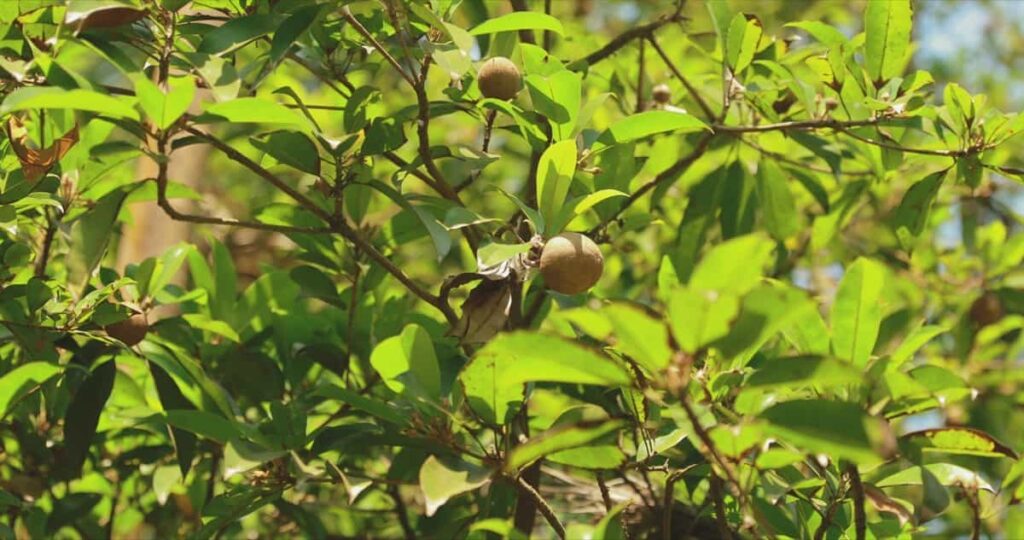
For example, pruning and fertilization are important in the early months, while pest control and irrigation take center stage later in the season. By following a carefully planned, you can increase the quantity and quality of your sapota crop, resulting in higher profits and a more successful harvest.
Sapodilla/Sapota Orchard Management
What is Sapota Farming and its Overview?
Sapota farming is cultivating sapota trees, also known as chiku, for their sweet and fleshy fruits. This hardy fruit tree is common in kitchen gardens across India, where people of all ages enjoy it. Originating in tropical America, Sapota is now widely cultivated in India, with an area of 156.1 thousand hectares dedicated to its growth and an annual production of 13.08 lacs MT. The tree is evergreen, with a strong trunk and a canopy that can grow up to 8m high. The fruit is a berry with a potato-like epicarp and can be seedless or contain 3-5 black, shiny seeds.
Importance of Month-Wise Planning for Sapota Orchard Operations
- Month-wise planning is critical for the successful operation of a sapota orchard.
- Each stage of sapota tree growth requires special care, and a month-by-month plan can ensure that each task is completed at the optimal time.
- Proper planning can prevent issues like pest infestations and diseases, which can harm the yield and quality of the fruit.
- Planning can help optimize resource usage, such as water and fertilizer, to reduce waste and costs.
- It can aid in ensuring a consistent supply of sapota fruit throughout the year.
- A well-planned sapota orchard can increase the quantity and quality of the crop, resulting in higher profits and more successful harvests.
- Developing a month-wise plan for sapota orchard operations is a wise investment that can yield significant returns.
In case you missed it: Optimizing Coconut Orchard Operations: A Comprehensive Management Guide for Month-wise Planning

Best Tips for Sapota Orchard Cultivation
Sapota, also known as chikoo, is a tropical fruit tree that can be grown under sub-tropical and temperate conditions, like mangoes. The cultivation of Sapota is successful in the coastal area. The high temperatures can adversely affect the flowers and fruits of the tree.
Soil: Sapota trees can grow on various soils, from sandy loam to clay loam. The tree can tolerate salty conditions to a great extent.
Cultivars: Some popular ones include Kalipati, with oval fruits and dark green leaves. Cricket Ball, with round and sweet fruits; and Chhatri, with an umbrella canopy and oval fruits. Calcutta Round has large fruits and is prone to disease, while Pala bears medium-sized oval fruits in clusters with thin skin and sweet flesh. Dwarpudi has small cricket ball-like fruits, and Dhola Diwani bears small, sweet oval fruits in the summers.
Propagation: Sapota can be propagated through grafting and air layering. Air layering is done during the monsoon season (July-August). Applying 100 to 200ppm Indole butyric acid solution to ringed bark before covering it in moss grass and plastic increases air layer success. Grafting ‘Khirnee’ seedlings are superior to Sapota seedlings. Khirnee seedlings can be grown or taken from woods. Grafting uses one-year-old seedlings. Khirnee seedlings are inarched in March and ready six months later.
Planting: Sapota in the field is planted in prepared pits in July and August. In a square planting plan, block planting can be done 8 m apart. If it is done on light soils, the planting distance may be reduced to 7 m. Thus, 140 to 175 plants are required for one hectare, which should be booked beforehand with a reputed nursery.
Climate: Although Sapota is a tropical fruit, it can be grown under sub-tropical and temperate conditions like mangoes. The cultivation of Sapota is successful in the coastal area. The high temperatures can adversely affect the flowers and fruits of the tree.
Flowering and Fruiting: Sapota flower all year in tropical climates, with two main seasons: July-November and February-March. It also blooms twice in subtropical climates, in October-November and April-May. The flowers are cross-pollinated, and GA2 or NAA can improve fruit retention.
Irrigation: Sapota can withstand low soil moisture levels reasonably well. However, for healthy growth and high output, plants may be irrigated every 7–10 days in the summer and every 20–25 days in the winter.
Manuring and Fertilization: In the second year following planting, apply 20 kg of farmyard manure, 50 g of urea, 60 g of superphosphate, and 20 g of muriate of potash. As the plant gets older, the doses go up.
Intercropping: During the early years of planting, intercropping with crops like grams/wheat, sarson, or pulses can be grown. Vegetables can also be successfully developed, but care should be taken not to damage the root system and scaffolds during ploughing.
Training and Pruning: A sturdy tree framework requires a strong trunk. Remove the lowest branches on the trunk of the sapota plants up to a height of 45 cm to train them. Since it bears on top of branches in leaf axils, trimming is not necessary.
In case you missed it: Optimizing Apple Orchard Operations: A Comprehensive Guide for Month-wise Planning
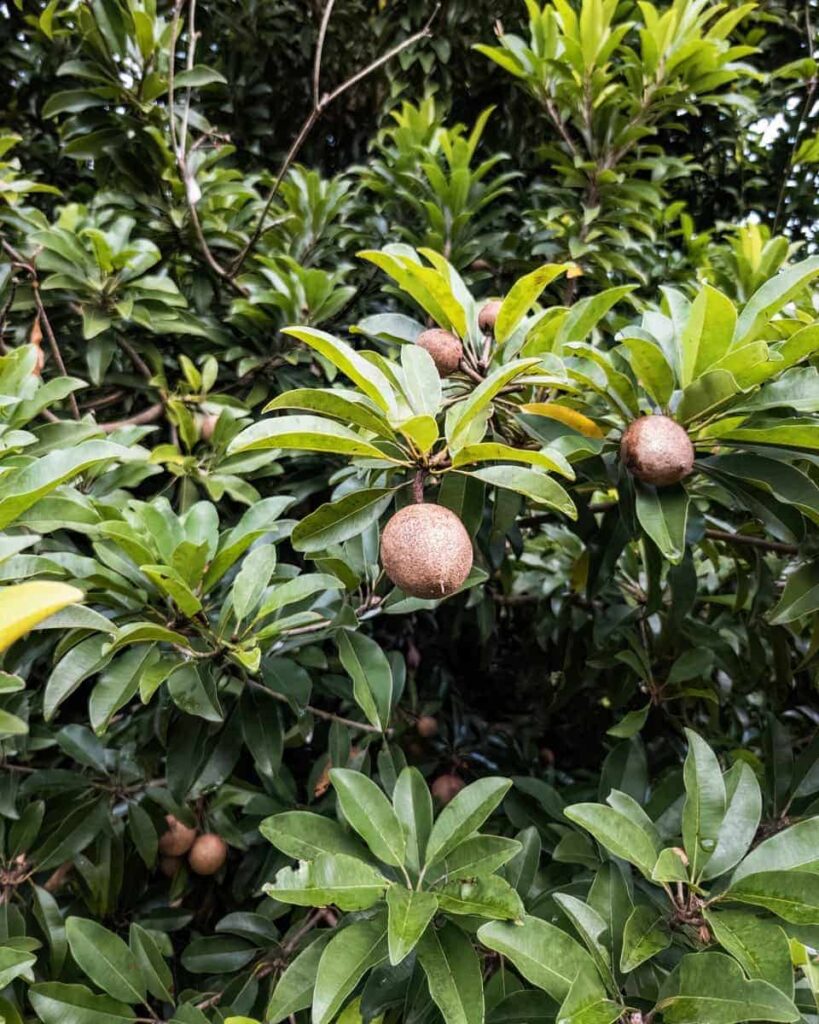
Improving Fruit Set: Spraying GA2 or NAA can improve the fruit set.
Pest and Disease Management: Sapota is affected by different pests and diseases that can reduce yield and quality. The common pests include fruit flies, scale insects, mealy bugs, and thrips, while the common diseases are leaf spots, stem rot, and fruit rot. A combined chemical and cultural practices can be used to control these pests and diseases. Chemical control involves the use of pesticides, while cultural practices include pruning, removing affected plant parts, proper sanitation, and crop rotation.
Harvesting and Handling of Fruit: Sapota should be harvested when fully mature as a climacteric fruit. When ripe, the fruits shed their scaly, brown skin. Mature fruits don’t have any green tissue or latex visible beneath the dark epicarp epidermis. Up until 25 to 30 years of age, a fully mature tree can produce over one quintal of fruit. The harvested fruit must be divided into three sizes—large, medium, and small—and loaded into wooden carts cushioned with paper scraps, straws, or banana leaves. Ripe fruits can be kept for a month at 2-3°C and 85–90% RH.
January Month Sapota Orchard Operations Planning
- Second Endo sulphon spray: Give a second spray at 2ml per liter in January. This will keep trees healthy and pest-free.
- Water plants every 8–10 days in January. Proper watering keeps the soil moist and promotes root growth.
- Sapota tree pruning and thinning: January is ideal. This method removes dead or unhealthy branches and promotes growth. Thinning improves fruit quality and size.
February Month Sapota Orchard Operations Planning
- Water the plants regularly for 8 to 10 days to ensure optimal growth and fruit production.
- Apply Bordeaux Paste on the trunk of the trees up to a height of 30 to 45 cm to prevent termite infestation and other fungal diseases.
- Monitor the plants for any signs or symptoms of disease pest attack, and take appropriate measures to control them.
- Prune the trees to remove dead or diseased branches and shape the trees for better fruit production.
March Month Sapota Orchard Operations Planning
- Regularly water the plants at 8 to 10 days intervals to ensure proper hydration.
- Apply one basket of dry leaf mulch or paddy straw to prevent evapotranspiration losses and weed growth in the basin.
April Month Sapota Orchard Operations Planning
- Soil suitability: Dig a profile pit of 3 x 3 x 3 ft and observe for calcareous nodules or sheetrock. Avoid soils with such features and ill-drained, waterlogged soils.
- Soil testing: Collect soil samples for analysis from each foot depth of the profile pit and send them to the nearest soil testing lab. Based on the report, soil pH should be considered suitable for sapota plantations, even if it’s moderately high (8.0 to 8.5).
- Water table: The subsurface water table in the soil should be below 2.5 meters.
- Irrigation: Ensure regular irrigation through drip or at least once in 5 to 7 days through basin irrigation.
- Soil maintenance: Hoeing and mulching should be done to keep the soil loose and friable.
In case you missed it: Optimizing Mango Orchard Operations: A Comprehensive Guide for Month-wise Planning
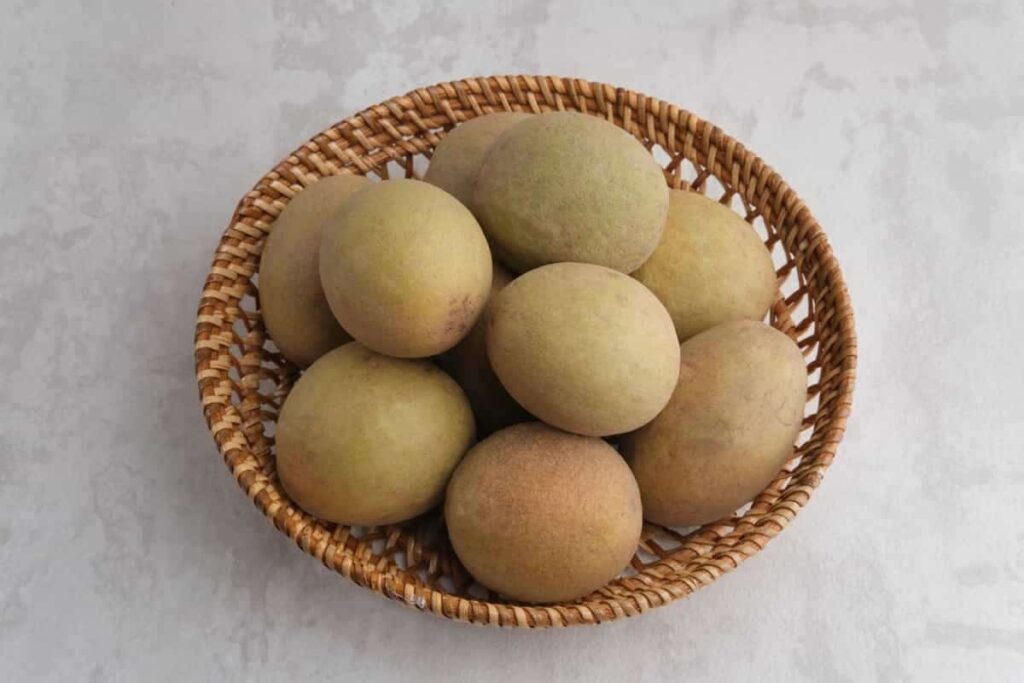
May Month Sapota Orchard Operations Planning
- Summer ploughing: Use an MB plow to plow the land two to three times to get a fine tilth and level the land.
- Alignment and peg marking: Mark the area for pit digging at 9×9 mtr (50-65 plants/acre) in light soils and at 10×10 m in heavy soils (40 plants/acre).
- Regular irrigation: Ensure regular irrigation through drip or at least once in 5 to 7 days intervals or through basins irrigation.
- Soil working: Work on the soil to create a soil mulch.
- Pit digging: While digging the pit, keep the top 1.5-foot soil to the right side and the bottom 1.5-foot soil to the left side of the pit. Allow the pit to expose to the sun for at least two weeks before filling the pits to control soil-borne pests and diseases. The pit size should be 90 x 90 x 90 cm.
- Procurement of plant material: Make arrangements for procuring plant material from reliable nurseries, preferably from Govt. nurseries or from nurseries recommended by the Department of Horticulture.
June Month Sapota Orchard Operations Planning
- Fill the pits with topsoil mixed with 50 kgs of Farm Yard Manure (FYM) + 1 kg Single Super Phosphate + 1 kg Neem Cake and 100 gm. Of 10% Follidol dust per pit.
- Ensure thorn fencing or any thick growing live fence to control cattle trespassing.
- Give mark out for trench cutting and complete the trench cutting for drip installation.
- With the onset of the monsoon, farmers can sow intercrops.
- If good soaking rains are received, apply 100 gms of urea, 125 gms of single super phosphate, 125 gms of MOP, and 50 to 60 Kg of FYM in the basins 60 cm away from the trunk.
- Plow the interspaces and sow green manure crops like Sunn-hemp or Cow-pea.
- If the monsoon is delayed, the application of manures and sowing of green manure crops can be taken up in July.
July Month Sapota Orchard Operations Planning
- Procure the plant material from selected nurseries with coordination from the CIG group members.
- Ensure that the plant material is of good quality to prevent future losses.
- Choose only vineer grafts at least one-year-old and have 4 to 6 flushes, with a 50 to 75 cm height.
- Check that the graft union is perfect and at least 15cm above the soil level in the poly bag. Ensure the sapling is healthy and free of pests and diseases, without side shoots on the rootstock.
- Arrange for transportation of plant material from the nursery to the planting site.
- Keep the saplings near a water source and water them regularly until planting is done.
- If there is a delay in good rains, soak the pits by giving irrigation or running the drip system. Ensure that the soil in the pit is at ground level. Otherwise, level it.
- Carefully remove the polythene sheet from the graft union and plant the sapling in the center of the pit without disturbing the earth ball around the root system. Ensure the graft union is 6 inches above the ground level after planting.
- Stake the plant with a strong support stick 3 to 4 feet long, and dip the bottom of the stick in black tar to avoid termite attacks.
- Water the plant immediately after planting and irrigate the plants every 7 to 10 days intervals.
In case you missed it: Maximizing Profits with a Comprehensive Tulsi Farming Business Plan
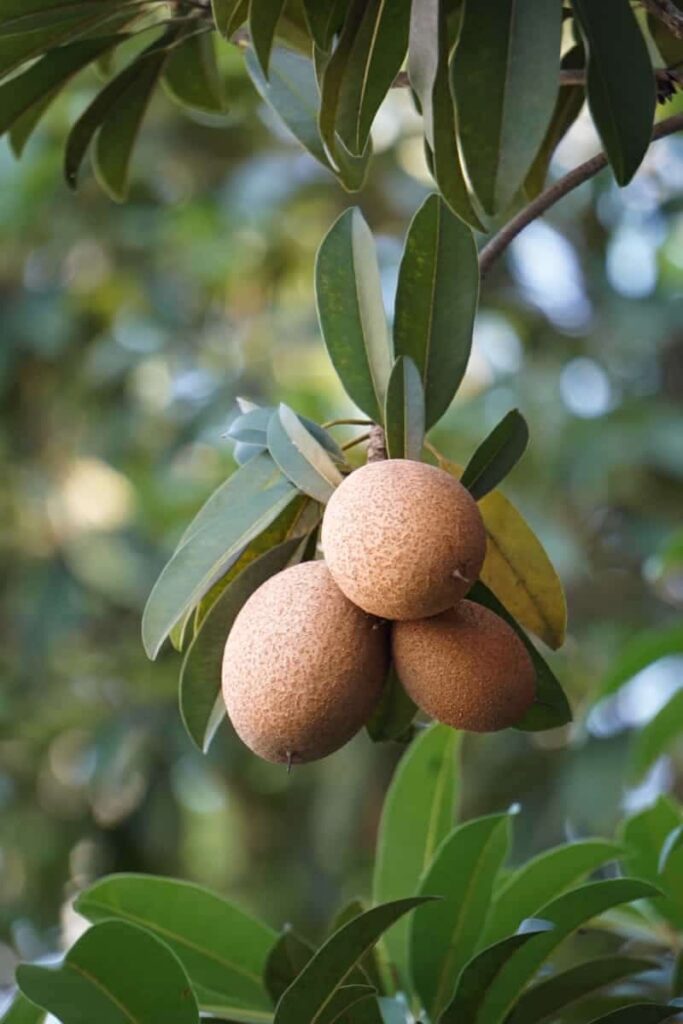
August Month Sapota Orchard Operations Planning
- Protect the new growth of sapota plants from caterpillar or leaf webber attack by spraying Quinolphos or Endosulphon @ 2 ml./lt. of water once a month.
- Weeding should be done once in two months during monsoon season to control weeds. Plough the inter-spaces with a blade-harrow or cultivator to keep the land weed-free.
- Mulch the basins with paddy husk, straw, or ground nut shells to avoid Evapotranspiration losses. Mulching also helps in the control of weeds in the basins.
- Remove the side shoots which appear on the rootstock.
- Control leaf spot diseases by spraying Copper Oxy Chloride (Blitox) @ three gm./lt. Of water. If not controlled in time, twig drying (Dieback) leads to the death of plants will take place.
September Month Sapota Orchard Operations Planning
- Termite control: Termites can damage trees and support sticks. Spray Chloropyriphos (Termex-C) at a rate of 5 ml per liter of water to the stem and support stick. Drench the basins with the same chemical to eliminate the termites.
- Pruning: Prune the side branches that grow from the main trunk at ground level. This helps to improve the tree’s structure and promote healthy growth.
October Month Sapota Orchard Operations Planning
- Gap filling: Replant any gaps due to plant deaths.
- Pruning: Remove side shoots from the rootstock.
- Planting: In high rainfall zones, planting can be done in Oct-Nov.
- Inter-cropping: If inter-cropping during June-July was not cultivated, farmers can sow intercrops for the Rabi season during this month.
- Fertilization: Apply about 100 gms of DAP in the basins and irrigate immediately.
November Month Sapota Orchard Operations Planning
- Control evapo-transpiration losses and weed growth by working the soil in the basins and mulching with dry leaves or paddy straw.
- Remove any side shoots on the rootstock to encourage strong, healthy growth.
- Regularly water the sapota trees at intervals of 8 to 10 days to ensure they receive the necessary moisture for healthy fruit production.
December Month Sapota Orchard Operations Planning
Apply COC 3 gms/lt and Endosulphon 2 ml/lt through the spray to control the Cercospora leaf spot and leaf webber.
In case you missed it: A Profitable Comprehensive Aloe Vera Farming Business Plan
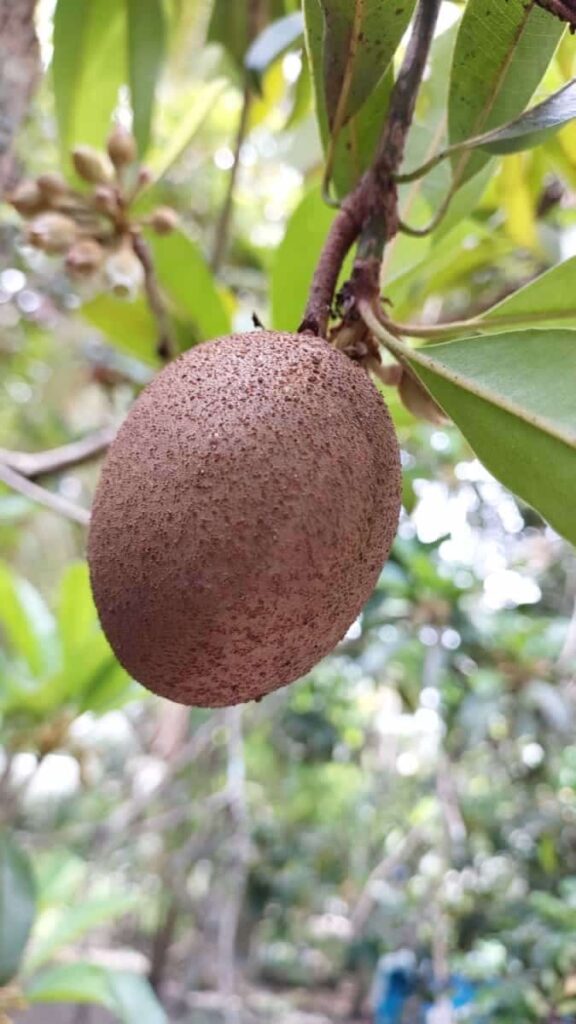
Conclusion
Optimizing sapota orchard operations requires a month-by-month approach to maximize yield. Proper management practices, including irrigation, pruning, pest and disease control, and harvesting, can improve tree health and productivity. Farmers can increase their chances of achieving maximum yield and profitability by implementing these practices.
- How to Maximize Sheep Farming Profit
- Broccoli Varieties: Choosing the Right Cultivars for Your Farm
- How to Raise Pigs in Your Own Backyard: A Comprehensive Guide
- Budget Friendly Sheep Shed Ideas: Cheap and Low-Cost Tips
- How Much Do Cattle Farmers Make: Revenue Streams in Cattle Farming
- Management Pests and Diseases in Your Cotton Field
- Sheep Farming Business Plan for Beginners
- Aquaponic Farming at Home: A Step-By-Step Guide
- Profitable Village Farming Business Ideas in 2024
- High-Yield Aquaculture: Fast-Growing Fish for Farming
- Effective Fish Pond Construction Techniques for Beginners
- Irrigation and Water Management in Pineapple Farming
- Blossom to Harvest: Mastering Flowering and Pollination in Papaya Farming
- Pig Fattening Essentials: From Selection to Sale for Beginners
- Raising Wagyu Cattle: A Complete Guide for Premium Beef Production
- Soil Types and Their Water Holding Capacity
- Optimizing Irrigation Schedules for Coconut Groves for Enhanced Yield
- Espresso Your Garden: Coffee Grounds for Healthier Acid-Loving Plants
- The Best Soil Mix for Snake Plants: How to Mix Your Own Snake Plant Soil
- Green Thumb Success: Expert Tips for Cultivating Greenhouse Beans All Year Round
- Bloom All Year Round: The Ultimate Guide to Indoor Hyacinth Care
- Eco-Friendly Gardening: How to Make Liquid Fertilizer from Kitchen Waste
- Ultimate Guide to Grow Anise in Pots: Explore Seed Propagation to Harvesting
- Guide to Raising Chester White Pigs: Discover Breed Facts to Growth Management
- Mastering the Elegance: The Ultimate Guide to Weeping Cherry Tree Care, Planting, and Maintenance
- Ultimate Guide to Planting Garlic in Grow Bags: Growing Strategies for Beginners
- How to Fix Spider Plant Leaf-Related Problems: Natural and Organic Remedies
- 10 Reasons Why Your Tulsi Plant is Shedding Leaves: Home Remedies and Solutions
- Optimizing Growth and Yield: The Advantages of Palm Bunch Ash Fertilizer
- Utilizing Neem Oil Extract as a Natural Pesticide for Hydrangea
- From Soil to Harvest: Various Ways in Which Farmers Can Use AI Tools
- Steps to Encourage and Induce Citrus Flowers: A Comprehensive Guide
- How to Fix Snake Plant Leaf-Related Issues: Natural and Organic Remedies
- Transform Your Garden into a Fragrant Oasis with Raat Ki Rani (Night Blooming Jasmine)
- Discover the Ideal Chicken Breeds for Philippine Farms
- How to Create a Poultry Egg Farm Business Plan for Profits
